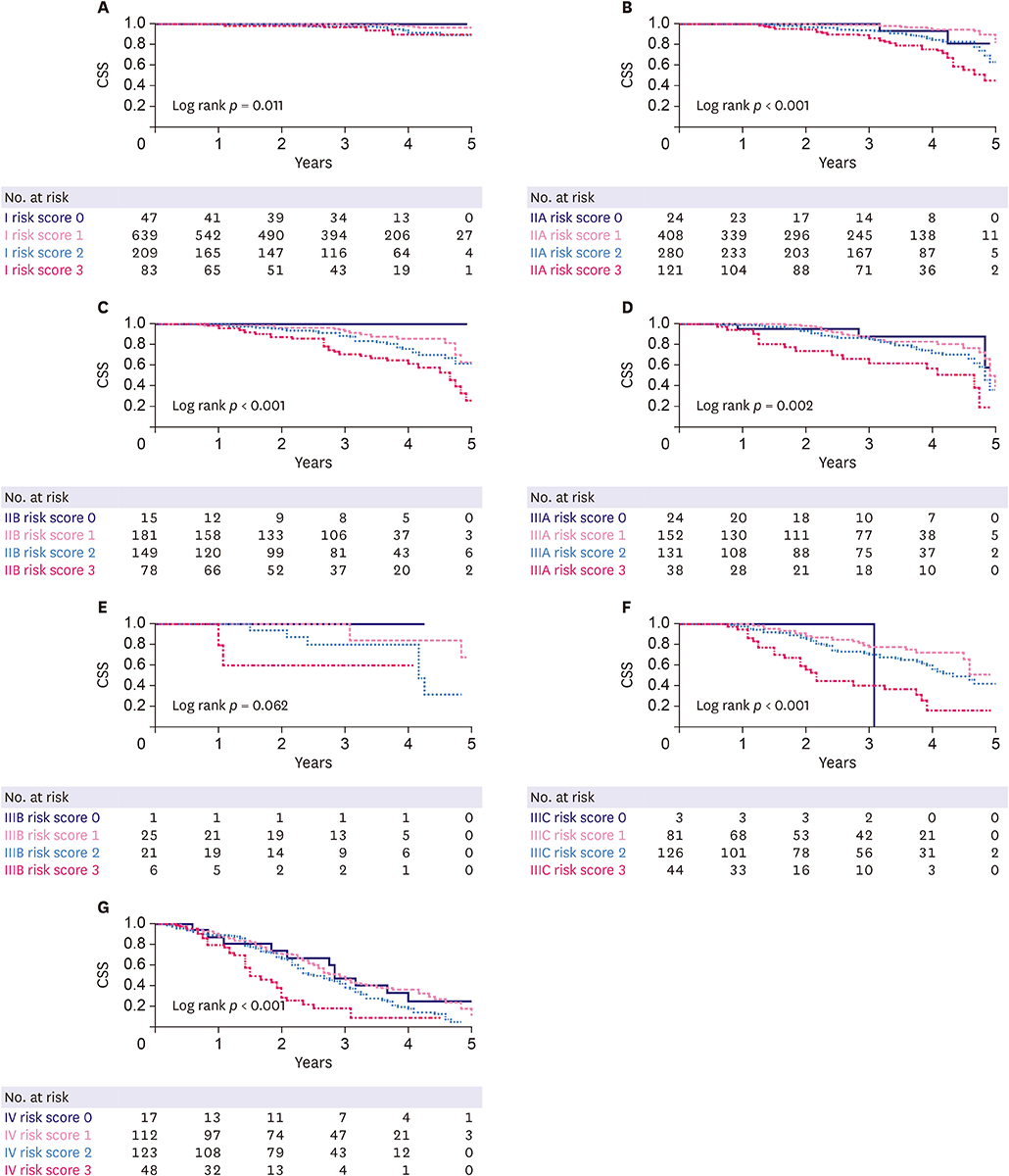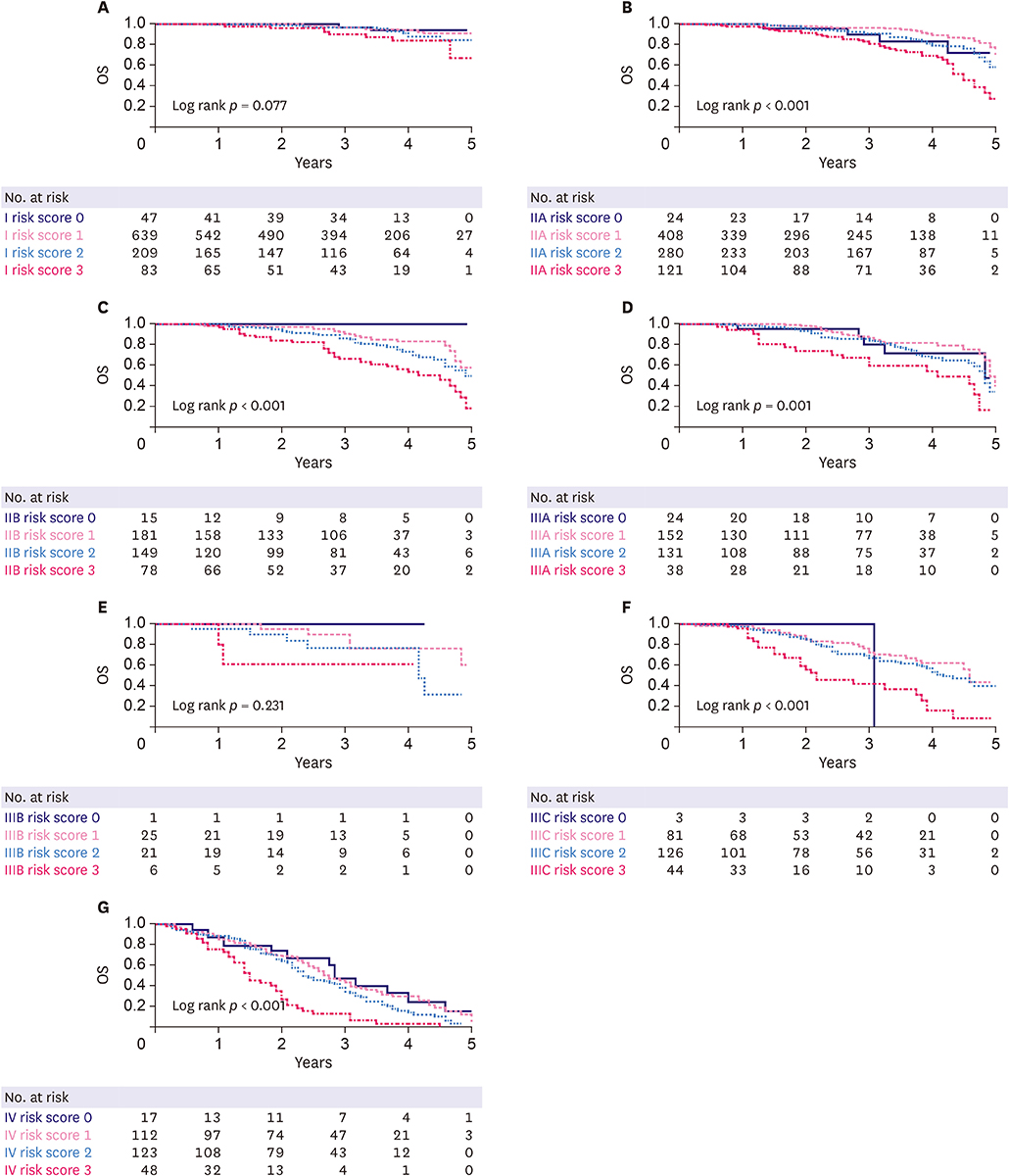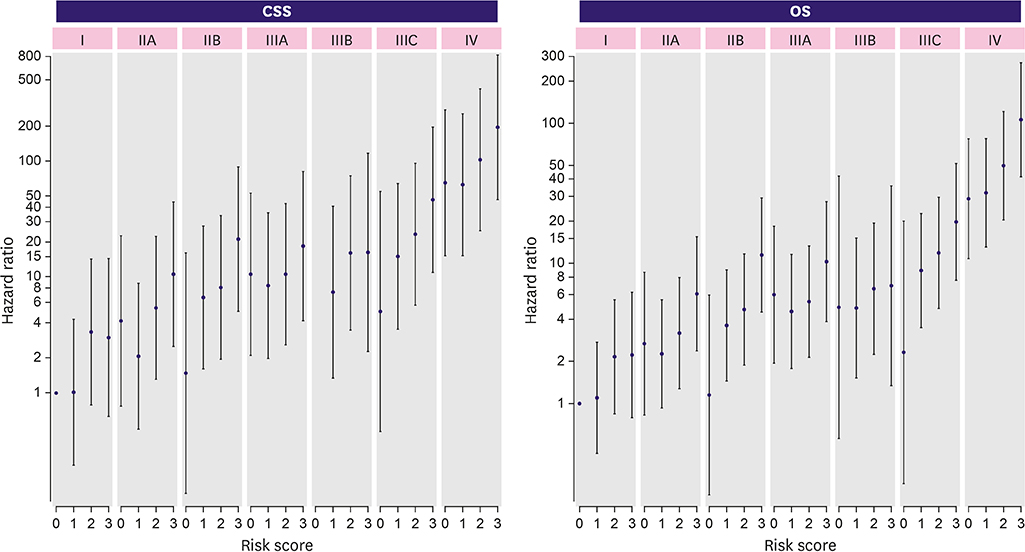J Breast Cancer.
2019 Jun;22(2):260-273. 10.4048/jbc.2019.22.e16.
Validation of a Risk Score Incorporating Tumor Characteristics into the American Joint Committee on Cancer Anatomic Stage for Breast Cancer
- Affiliations
-
- 1Lee Kong Chian School of Medicine, Nangyang Technological University of Singapore, Singapore.
- 2Department of Radiation Oncology, National Cancer Centre Singapore, Singapore. wong.ru.xin@singhealth.com.sg
- 3Clinical Trials and Epidemiological Sciences, National Cancer Centre Singapore, Singapore.
- 4Department of Medical Oncology, National Cancer Centre Singapore, Singapore.
- KMID: 2450120
- DOI: http://doi.org/10.4048/jbc.2019.22.e16
Abstract
- PURPOSE
The American Joint Committee on Cancer 8th edition (AJCC8) prognostic stage (PS) was implemented January 1, 2018, but it is complex due to multiple permutations. A North American group proposed a simpler system using the anatomic stage with a risk score system (RSS) of 1 point each for grade 3 tumor and human epithelial growth factor receptor 2 (HER2) and estrogen receptor (ER) negativity. Here we aimed to evaluate this risk score system with our database of Asian breast cancer patients and compare it against the AJCC8 PS.
METHODS
Patients diagnosed with breast cancer stage I-IV in 2006-2012 were identified in the SingHealth Joint Breast Cancer Registry. Five-year breast cancer-specific survival (CSS) and overall survival (OS) were calculated for each anatomic stage according to the risk score and compared with the AJCC8 PS.
RESULTS
A total of 6,656 patients were analyzed. The median follow-up was 61 (interquartile range, 37-90) months. There was a high receipt of endocrine therapy (84.6% of ER+ patients), chemotherapy (84.3% of node-positive patients), and trastuzumab (86.0% of HER2+ patients). Within each anatomic stage, there were significant differences in survival in all sub-stages except IIIB. On multivariate analysis, the hazard ratio for negative ER was 1.74 (1.48-2.06), for negative HER2 was 1.49 (1.26-1.74), and for grade 3 was 1.84 (1.55-2.19). On multivariate analysis controlled for age, ethnicity, and receipt of chemotherapy, the RSS (Akaike information criterion [AIC] = 10,649.45; Harrell's Concordance Index [C] = 0.85) was not inferior to the AJCC8 PS (AIC = 10,726.65; C = 0.84) for CSS, nor was the RSS (AIC = 14,714.4; C = 0.82) inferior to the AJCC8 PS (AIC = 14,784.69; C = 0.81) for OS.
CONCLUSION
The RSS is comparable to the AJCC8 PS for a patient population receiving chemotherapy as well as endocrine- and HER2-targeted therapy and further stratifies stage IV patients.
MeSH Terms
Figure
Reference
-
1. Giuliano AE, Connolly JL, Edge SB, Mittendorf EA, Rugo HS, Solin LJ, et al. Breast Cancer-Major changes in the American Joint Committee on Cancer eighth edition cancer staging manual. CA Cancer J Clin. 2017; 67:290–303.
Article2. Hu H, Wei W, Yi X, Xin L, Liu Y. A retrospective analysis of clinical utility of AJCC 8th edition cancer staging system for breast cancer. World J Oncol. 2017; 8:71–75.
Article3. Kim I, Choi HJ, Ryu JM, Lee SK, Yu JH, Kim SW, et al. Prognostic validation of the American joint committee on cancer 8th staging system in 24,014 Korean patients with breast cancer. J Breast Cancer. 2018; 21:173–181.
Article4. Weiss A, Chavez-MacGregor M, Lichtensztajn DY, Yi M, Tadros A, Hortobagyi GN, et al. Validation study of the American Joint Committee on Cancer eighth edition prognostic stage compared with the anatomic stage in breast cancer. JAMA Oncol. 2018; 4:203–209.
Article5. Wong RX, Wong FY, Lim J, Lian WX, Yap YS. Validation of the AJCC 8th prognostic system for breast cancer in an Asian healthcare setting. Breast. 2018; 40:38–44.
Article6. Cserni G, Chmielik E, Cserni B, Tot T. The new TNM-based staging of breast cancer. Virchows Arch. 2018; 472:697–703.
Article7. Li X, Zhang Y, Meisel J, Jiang R, Behera M, Peng L. Validation of the newly proposed American Joint Committee on Cancer (AJCC) breast cancer prognostic staging group and proposing a new staging system using the National Cancer Database. Breast Cancer Res Treat. 2018; 171:303–313.
Article8. Weiss A, King TA, Hunt KK, Mittendorf EA. Incorporating biologic factors into the american joint committee on cancer breast cancer staging system: review of the supporting evidence. Surg Clin North Am. 2018; 98:687–702.
Article9. Chavez-MacGregor M, Mittendorf EA, Clarke CA, Lichtensztajn DY, Hunt KK, Giordano SH. Incorporating tumor characteristics to the American joint committee on cancer breast cancer staging system. Oncologist. 2017; 22:1292–1300.
Article10. Hammond ME, Hayes DF, Dowsett M, Allred DC, Hagerty KL, Badve S, et al. American Society of Clinical Oncology/College of American Pathologists guideline recommendations for immunohistochemical testing of estrogen and progesterone receptors in breast cancer. J Clin Oncol. 2010; 28:2784–2795.
Article11. Wolff AC, Hammond ME, Hicks DG, Dowsett M, McShane LM, Allison KH, et al. Recommendations for human epidermal growth factor receptor 2 testing in breast cancer: American Society of Clinical Oncology/College of American Pathologists clinical practice guideline update. J Clin Oncol. 2013; 31:3997–4013.
Article12. Edge SB. American Joint Committee on Cancer. AJCC Cancer Staging Handbook: from the AJCC Cancer Staging Manual. New York: Springer;2010.13. Lee MK, Varzi LA, Chung DU, Cao MA, Gornbein J, Apple SK, et al. The effect of young age in hormone receptor positive breast cancer. BioMed Res Int. 2015; 2015:325715.
Article14. Xin WR, Kwok LL, Yong WF. Screening uptake differences are not implicated in poorer breast cancer outcomes among Singaporean Malay women. J Breast Cancer. 2017; 20:183–191.
Article15. Wong FY, Tham WY, Nei WL, Lim C, Miao H. Age exerts a continuous effect in the outcomes of Asian breast cancer patients treated with breast-conserving therapy. Cancer Commun (Lond). 2018; 38:39.
Article16. Chia SK, Speers CH, D'yachkova Y, Kang A, Malfair-Taylor S, Barnett J, et al. The impact of new chemotherapeutic and hormone agents on survival in a population-based cohort of women with metastatic breast cancer. Cancer. 2007; 110:973–979.
Article17. Lobbezoo DJ, van Kampen RJ, Voogd AC, Dercksen MW, van den Berkmortel F, Smilde TJ, et al. Prognosis of metastatic breast cancer subtypes: the hormone receptor/HER2-positive subtype is associated with the most favorable outcome. Breast Cancer Res Treat. 2013; 141:507–514.
Article18. Savci-Heijink CD, Halfwerk H, Hooijer GK, Horlings HM, Wesseling J, van de Vijver MJ. Retrospective analysis of metastatic behaviour of breast cancer subtypes. Breast Cancer Res Treat. 2015; 150:547–557.
Article19. Mamounas EP, Tang G, Fisher B, Paik S, Shak S, Costantino JP, et al. Association between the 21-gene recurrence score assay and risk of locoregional recurrence in node-negative, estrogen receptor-positive breast cancer: results from NSABP B-14 and NSABP B-20. J Clin Oncol. 2010; 28:1677–1683.
Article20. Sparano JA, Gray RJ, Makower DF, Pritchard KI, Albain KS, Hayes DF, et al. Adjuvant chemotherapy guided by a 21-gene expression assay in breast cancer. N Engl J Med. 2018; 379:111–121.
Article21. Mittendorf EA, Chavez-MacGregor M, Vila J, Yi M, Lichtensztajn DY, Clarke CA, et al. Bioscore: A staging system for breast cancer patients that reflects the prognostic significance of underlying tumor biology. Ann Surg Oncol. 2017; 24:3502–3509.
Article22. Yi M, Mittendorf EA, Cormier JN, Buchholz TA, Bilimoria K, Sahin AA, et al. Novel staging system for predicting disease-specific survival in patients with breast cancer treated with surgery as the first intervention: time to modify the current American Joint Committee on Cancer staging system. J Clin Oncol. 2011; 29:4654–4661.
Article23. Goldhirsch A, Winer EP, Coates AS, Gelber RD, Piccart-Gebhart M, Thürlimann B, et al. Personalizing the treatment of women with early breast cancer: highlights of the St Gallen International Expert Consensus on the Primary Therapy of Early Breast Cancer 2013. Ann Oncol. 2013; 24:2206–2223.
Article24. Vasconcelos I, Hussainzada A, Berger S, Fietze E, Linke J, Siedentopf F, et al. The St. Gallen surrogate classification for breast cancer subtypes successfully predicts tumor presenting features, nodal involvement, recurrence patterns and disease free survival. Breast. 2016; 29:181–185.
Article25. Prat A, Cheang MC, Martín M, Parker JS, Carrasco E, Caballero R, et al. Prognostic significance of progesterone receptor-positive tumor cells within immunohistochemically defined luminal A breast cancer. J Clin Oncol. 2013; 31:203–209.
Article26. Hefti MM, Hu R, Knoblauch NW, Collins LC, Haibe-Kains B, Tamimi RM, et al. Estrogen receptor negative/progesterone receptor positive breast cancer is not a reproducible subtype. Breast Cancer Res. 2013; 15:R68.
Article27. Dawood S, Broglio K, Buzdar AU, Hortobagyi GN, Giordano SH. Prognosis of women with metastatic breast cancer by HER2 status and trastuzumab treatment: an institutional-based review. J Clin Oncol. 2010; 28:92–98.
Article28. Metzger-Filho O, Sun Z, Viale G, Price KN, Crivellari D, Snyder RD, et al. Patterns of Recurrence and outcome according to breast cancer subtypes in lymph node-negative disease: results from international breast cancer study group trials VIII and IX. J Clin Oncol. 2013; 31:3083–3090.
Article
- Full Text Links
- Actions
-
Cited
- CITED
-
- Close
- Share
- Similar articles
-
- Development of an Excel Program for the Updated Eighth American Joint Committee on Cancer Breast Cancer Staging System
- Prognostic Validation of the American Joint Committee on Cancer 8th Staging System in 24,014 Korean Patients with Breast Cancer
- Assessment of the Prognostic Staging System of American Joint Committee on Cancer 8th Edition for Breast Cancer: Comparisons with the Conventional Anatomic Staging System
- Introduction of a New Staging System of Breast Cancer for Radiologists: An Emphasis on the Prognostic Stage
- Sentinel Lymph Node in Breast Cancer: Review Article from a Pathologist's Point of View




